Elizabeth Ganguly’s home garden is a work of art
Elizabeth Ganguly has developed one of the country’s most striking gardens at her home on South Australia’s Fleurieu Peninsular.
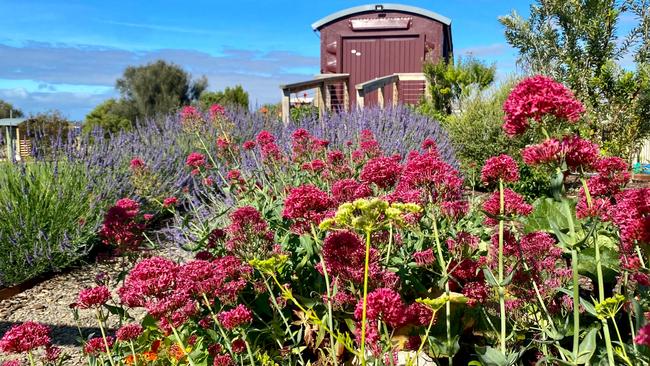
Garden designer Elizabeth Ganguly drew on all her skills when it came to creating her own garden, Indigo Blue, at Port Elliott on South Australia’s Fleurieu Peninsular. The half-hectare block 400m from the beach, with not much in between, suffers from strong and salty winds. And the soil is a reactive limestone clay, poorly drained, with a very high pH of 8 to 9. It was in total contrast to her garden in the Adelaide Hills where camellias, azaleas and deciduous trees thrived on rich, acidic soil.
Indigo Blue was named by Elizabeth’s late husband, Barry, for the multiple blues of their sea views. It was a bare, flat paddock when they bought it in the early 1990s, planning to build a holiday house at the historic coastal town, but it wasn’t until 2009 that Elizabeth started the garden, using stockpiled topsoil from their excavations to create some interesting contours and mounds. Her earliest plantings were windbreaks of casuarinas, melaleucas, acacias and carobs. The historic Steam Ranger Cockle Train, which runs from Goolwa to Victor Harbour and passes along one boundary, inspired the railway theme that ties the garden to its place. The main path is laid out like a railway line, bordered with salvaged rail; the garden shed is an old SA Rail goods van, and an old railway phone box now serves as a tool shed. To watch the trains go by, there’s an elevated platform built from salvaged sleepers and wharf timbers, complete with a replica station sign bearing the property’s name.
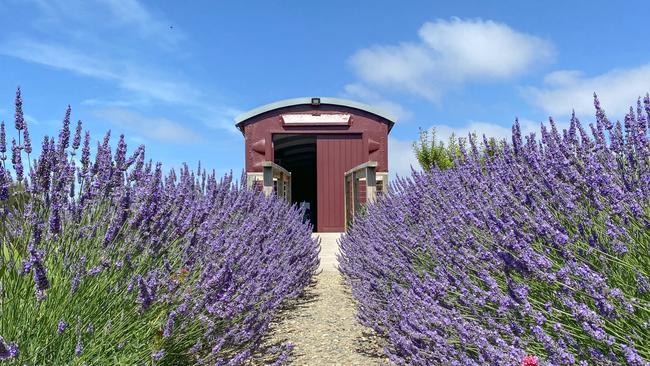
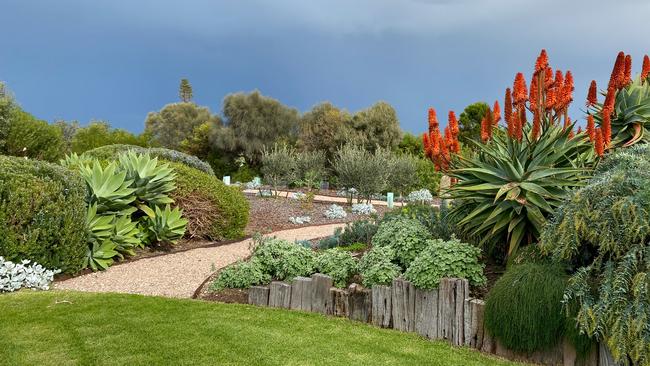
When Elizabeth and Barry moved to Indigo Blue permanently in 2016, she started working more intensively on the garden. Resilient native and Mediterranean species are used to create striking combinations of foliage shapes, colours and textures. Plants with bold architectural form, such as Agave americana ‘Variegata’ (confined in red tanks) andcandelabra aloes(Aloe arborescens), with their striking orange flowers through winter, are joined by other succulents such as black-leafed Aeonium ‘Schwatzkopf’ and Cotyledon ‘Silver Waves’. Many shrubs are clipped into spheres or flowing organic shapes typical of windy coastal areas, such as rosemary, coastal rosemary (Westringia), germander (Teucrium) and boobialla (Myoporum insulare). Albany woolly bush (Adenananthos), also called pat bush for its irresistibly soft foliage, adds texture along with various native grasses. “It’s all about selecting the right plants, but nothing grows tall here because of the winds,” says Elizabeth, although she has planted six Norfolk Island pines to add height in the long term. “I planted them as tubestock and they’re now about 4m tall.” Blue and purple flowers include rosemary, English lavender, native hibiscus (Alyogyne huegelii) and pride of Madeira (Echium).
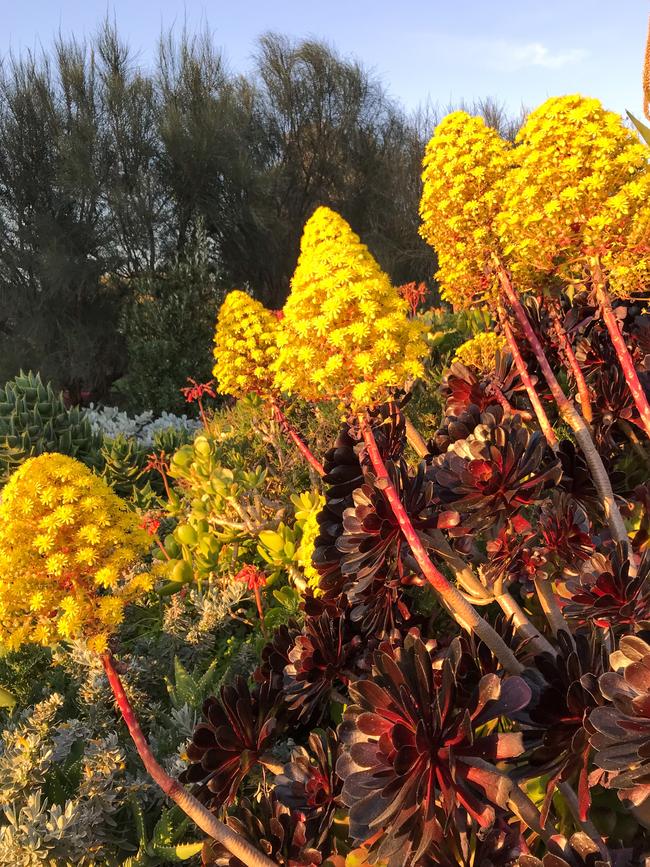
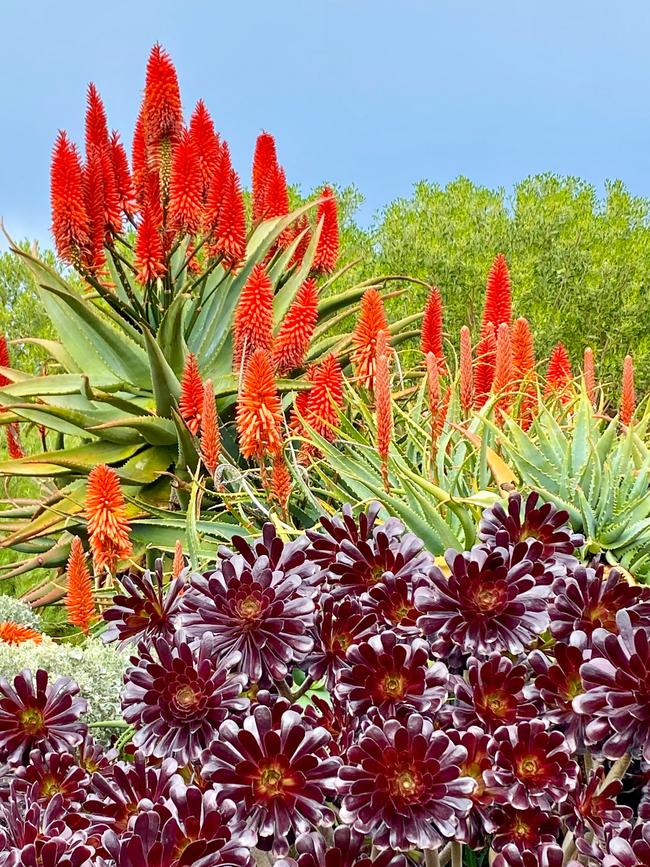
Stone walling is a feature of the garden, built by local stonemasons in the manner of historic local buildings, while the Olive Walk, designed in consultation with landscaper Mark Burnett, has a stone circle at its mid-point. Dotted throughout the garden are sculptures by local artists and birdbaths, while the Gin Walk features juniper, citrus, cucumber and other botanicals used in making a classic gin and tonic.
Indigo Blue is open October 6-7 through Open Gardens SA; opengardenssa.org.au
Q&A
Does “half sun, half shade” mean sun for half the day or filtered sun all day? My vegies only get afternoon sun and I’m not having much luck.
Alec’s dad, by email
Generally it means the former. But the amount of sun different plants need or can tolerate varies with climatic region and time of year. Afternoon sun is hotter than morning sun, and summer sun is much hotter than winter sun. Humidity can also moderate the effects of direct sun. Many vegetables need ample sunlight to produce crops but might need protection from harsh summer sun in the hottest hours. You need to know your garden and experiment with different crops, positions and timing.
What beautiful plants could we use as an edging around a shady raised bed containing hydrangeas, clivias and hellebores? It’s a showpiece as visitors arrive. We have winter frosts and dry, hot summers.
Kym Skews, East Gippsland, Victoria
The Mediterranean species of Epimedium are great in dry shade – try E. x versicolour var. neosulphureum or ‘Cherry Tart’, and E. puberigerum. Epimediums have orchid-like flowers in spring and some have leaves that seasonally colour or have interesting markings. Also look at aromatic cranesbill (Geranium macrorrhizum) with fragrant foliage that colours in winter and pink or white flowers during the warm months. It forms a dense groundcover to about 30cm.
From two bulbs of Scadoxus in a pot 10 years ago, I now have a dozen or so flowering. Should I divide them or do they prefer being crowded?
Jayne Taylor, by email
Paintbrush or blood lilies have spectacular orange-red flower heads. Your species, S. puniceus, thrives in part shade and needs a dry winter. It prefers to be left undisturbed but once the pot is full, you can carefully divide bulbs when dormant in winter.
Send your questions to helenyoungtwig@gmail.com. The best question for September wins Fiskars’ large PowerGear X Bypass Lopper, worth $145; fiskars.com.au
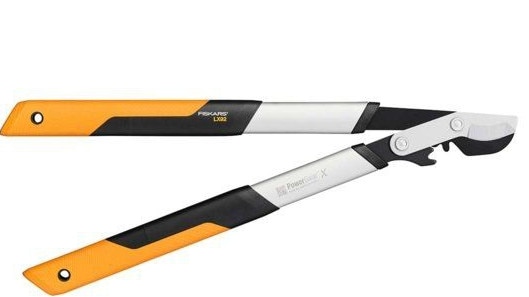




To join the conversation, please log in. Don't have an account? Register
Join the conversation, you are commenting as Logout